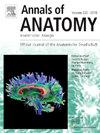对意大利中部一个种群中三个年龄段的狍子(Capreolus capreolus)进行生物计量分析。
IF 2
3区 医学
Q2 ANATOMY & MORPHOLOGY
引用次数: 0
摘要
本文章由计算机程序翻译,如有差异,请以英文原文为准。
Biometric analysis applied to three age classes of roe deer (Capreolus capreolus) in a population of central Italy
Roe deer are often used as bioindicators; however, little is known about the potential relationship between biometric parameters and the different phenological developmental phases of males compared to females.
This study focuses on the analysis of biometric data of three age groups (juveniles, subadults and adults) of the roe deer population, performed on samples collected during the period 2017–2023. The aim is to evaluate the relationship between body/cranial parameters and sex-specific developmental phases, both to create a database and to provide morphological information useful for deepening the knowledge about the roe deer population and for planning management actions, including selective hunting.
Eight cranial linear distances were measured to the nearest 0.05 mm with calipers on the cranium of the roe deer, and four body linear distances were measured to the nearest 1 cm with flexible measuring devices. Data were analysed using ANOVA. Multivariate size-constrained factorial analysis was applied to investigate both shape changes and the shape morphology of the cranium for each age-sex group.
Analysis revealed weak sexual dimorphism; significant differences emerged in head-trunk length, height at withers and hock length in adults, while chest circumference remained similar. Cranial measurements showed males develop wider cranium earlier, whereas females exhibit prolonged growth in sensory related structures. Factorial analysis confirmed size as the primary differentiating factor among age classes. Males reach adult morphology faster, while females continue cranial development into the second year.
Data underline the importance of age and sex in the morphological development of roe deer and highlight that understanding the relationship between body parameters and developmental stages is essential to refine selective hunting criteria and ensure sustainable population management.
求助全文
通过发布文献求助,成功后即可免费获取论文全文。
去求助
来源期刊

Annals of Anatomy-Anatomischer Anzeiger
医学-解剖学与形态学
CiteScore
4.40
自引率
22.70%
发文量
137
审稿时长
33 days
期刊介绍:
Annals of Anatomy publish peer reviewed original articles as well as brief review articles. The journal is open to original papers covering a link between anatomy and areas such as
•molecular biology,
•cell biology
•reproductive biology
•immunobiology
•developmental biology, neurobiology
•embryology as well as
•neuroanatomy
•neuroimmunology
•clinical anatomy
•comparative anatomy
•modern imaging techniques
•evolution, and especially also
•aging
 求助内容:
求助内容: 应助结果提醒方式:
应助结果提醒方式:


